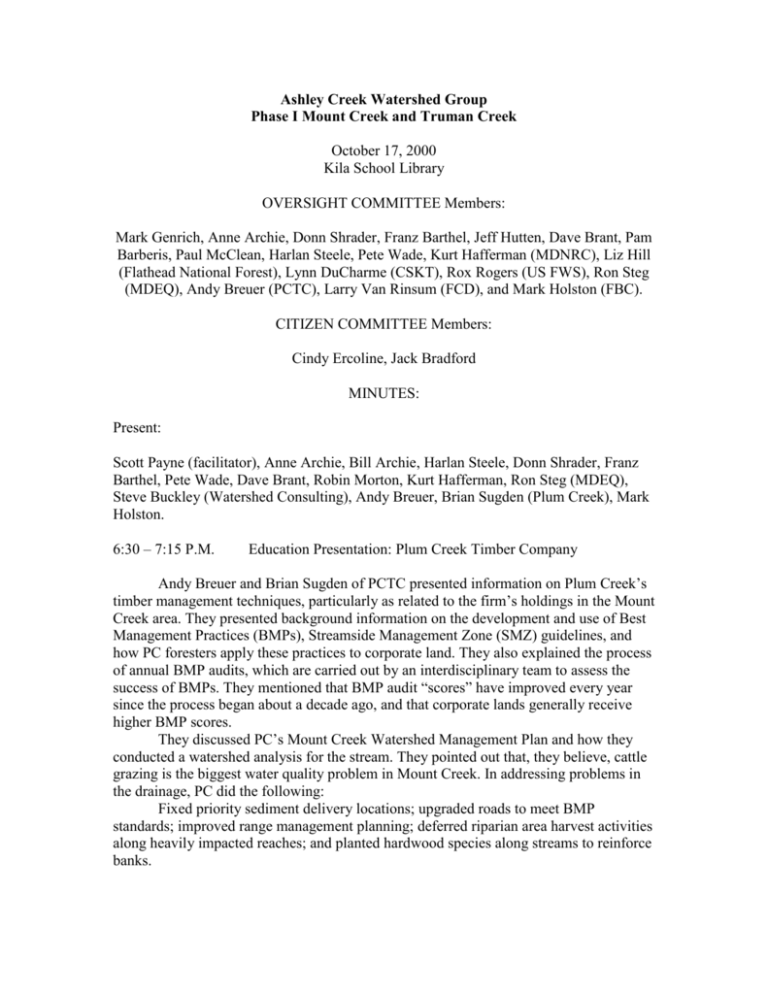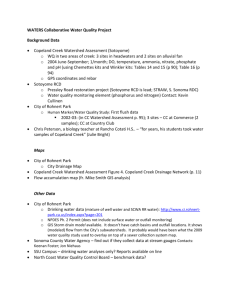Ashley Creek Watershed Group
advertisement

Ashley Creek Watershed Group Phase I Mount Creek and Truman Creek October 17, 2000 Kila School Library OVERSIGHT COMMITTEE Members: Mark Genrich, Anne Archie, Donn Shrader, Franz Barthel, Jeff Hutten, Dave Brant, Pam Barberis, Paul McClean, Harlan Steele, Pete Wade, Kurt Hafferman (MDNRC), Liz Hill (Flathead National Forest), Lynn DuCharme (CSKT), Rox Rogers (US FWS), Ron Steg (MDEQ), Andy Breuer (PCTC), Larry Van Rinsum (FCD), and Mark Holston (FBC). CITIZEN COMMITTEE Members: Cindy Ercoline, Jack Bradford MINUTES: Present: Scott Payne (facilitator), Anne Archie, Bill Archie, Harlan Steele, Donn Shrader, Franz Barthel, Pete Wade, Dave Brant, Robin Morton, Kurt Hafferman, Ron Steg (MDEQ), Steve Buckley (Watershed Consulting), Andy Breuer, Brian Sugden (Plum Creek), Mark Holston. 6:30 – 7:15 P.M. Education Presentation: Plum Creek Timber Company Andy Breuer and Brian Sugden of PCTC presented information on Plum Creek’s timber management techniques, particularly as related to the firm’s holdings in the Mount Creek area. They presented background information on the development and use of Best Management Practices (BMPs), Streamside Management Zone (SMZ) guidelines, and how PC foresters apply these practices to corporate land. They also explained the process of annual BMP audits, which are carried out by an interdisciplinary team to assess the success of BMPs. They mentioned that BMP audit “scores” have improved every year since the process began about a decade ago, and that corporate lands generally receive higher BMP scores. They discussed PC’s Mount Creek Watershed Management Plan and how they conducted a watershed analysis for the stream. They pointed out that, they believe, cattle grazing is the biggest water quality problem in Mount Creek. In addressing problems in the drainage, PC did the following: Fixed priority sediment delivery locations; upgraded roads to meet BMP standards; improved range management planning; deferred riparian area harvest activities along heavily impacted reaches; and planted hardwood species along streams to reinforce banks. Sugden and Breuer also updated the group on Plum Creek’s Native Fish Habitat Conservation Plan, which they explained defines new management priorities on 1.6 million acres of corporate timber land with the protection of native fish habitat as the guiding factor. 7:30 P.M. Meeting commenced. 104 (b)(3) Grant Update: Scott Payne discussed the grant, which will be used by Watershed Consulting to conduct an assessment of wetlands and riparian areas in the drainage. Several members expressed their concern about the delay in beginning field work, a delay exacerbated by the forest fire season and unavailability of key agency personnel to participate at this time. Payne and Steve Buckley, Watershed Consulting, discussed the importance of obtaining and analyzing available information before field work begins. Aerial photos of the region taken in the 1980s and brought to the meeting by Kurt Hafferman were displayed and discussed. Obtaining more current photos, Buckley explained, will allow the group an opportunity to observe in better detail problems that might affect water quality in the drainage. Payne explained that through a program at the University of Montana, the group will be able to obtain the services of a student intern, who will, at little expense, assist in the collection of all available data on the watershed. At upcoming meetings, the group will participate in reviewing additional aerial photos of the watershed. 319 Grant Project: Hafferman discussed options for a grant-funded demonstration project on Mount Creek. He said one example would be to install a sediment trap at the county road cut area downstream from Brown’s Meadow. He said he is also considering an area that would include Mount Creek from Robin Morton’s property downstream to Ashley Creek. He also suggested a project demonstrating better culvert installations at road crossings. He said using concrete aprons at the entrance to the culvert is a good way to dissipate the water’s energy. Hafferman plans site visitations to further assess the practicality of such projects. DEQ Impaired Water Bodies Letter: The draft letter was discussed. It was agreed that the FBC office would mail copies of the letter to all members, and that they would have one week to make comments for changes. Once those comments have been received and incorporated into the letter, it will be prepared for the signature of the acting chair and then mailed to MDEQ. Other Business: Dave Brant agreed to provide the Education Presentation at the next meeting. He will seek to involve his daughter, who authored an extensive academic report on Ashley Creek while at student at the University of Montana. Brant’s theme will be the history of Ashley Creek. It was agreed that further discussion of the feasibility a “Management Plan” for Ashley Lake and Stream would be deferred until after Brant’s presentation on the watershed’s history. It was agreed that future topics for education presentations would include land conservancy organizations, other local watershed groups, noxious weeds, Montana Fish, Wildlife & Parks (MFWP), and the Natural Resource Conservation Service (NRCS). It was agreed that a roster for group membership would be prepared and distributed at the next meeting. The roster will include names, phone numbers, and postal and e-mail addresses. The next meeting was set for Tuesday, November 21, 2000 in the Kila School Gymnasium (or library). 10 P.M. Meeting adjourned. Minutes prepared and submitted by Mark Holston, Flathead Basin Commission. Flathead Basin Commission 33 2nd Street East Kalispell, MT 59901 752.0081 fbc@digisys.net






